Results 511 to 520 of 12091
Thread: Anandtech News
-
05-31-11, 06:10 PM #511
Anandtech: Computex 2011: MSI's X79 and Llano Motherboards
By now you know that Ivy Bridge (due out in March - April of 2012) will be backwards compatible with some 6-series motherboards. The CPU itself has a PCIe 3.0 controller on-die, however MSI tells us that without modifications to existing motherboard designs you won't be able to properly support the 3.0 spec.
MSI's Z68A-GD80 (G3) features new circuitry and switches between the CPU socket and the x16 slots that will apparently allow the motherboard to operate at PCIe Gen 3 speeds. The problem seems confined to the switches that motherboard makers use to automatically divide the 16 PCIe lanes coming from the CPU into 1 x16 or 2 x8. MSI claims that when Ivy Bridge comes out, the Z68A-GD80 (G3) will be fully PCIe Gen 3 compliant.
Of course MSI had a Socket-2011 X79 motherboard on display in addition to a pair of Socket-FM1 Llano boards. I'm hearing late summer for the desktop Llano launch at this point.
Those of you waiting for Bulldozer performance results from Computex, I'm afraid we're not going to see anything representative of final hardware. I did hear that the upcoming B2 stepping would restore performance to Bulldozer's original targets, however it's unclear how those compare to Sandy Bridge. The other thing I did hear at the show floor regarding Bulldozer was about its clock speed. Current B1 stepping parts are easily hitting 3.8GHz which is what the high end SKU may actually ship at (with turbo support up to 4.2GHz). I'm waiting for more confirmation but it sounds like Bulldozer will at least clock very high.
{gallery 1107}
More...
-
05-31-11, 08:30 PM #512
Anandtech: Computex 2011: Battle of the 600W PSUs
It wouldn’t be a trade show without a little bit of extreme thinking, to grab some headlines and show the punters how creative their engineers are. As part of our Computex coverage, we’ve seen all manner of graphics cards – at the high end of the spectrum, we’re seeing custom AMD and NVIDIA cards that supposedly push 600 watts!
From ASUS, building on the ‘halo’ of the ROG Mars, the Republic of Gamers branded Mars II is being shown – a dual GPU featuring two 580s on one PCB in a triple slot format. There’s no mention of clock speeds, but we’ve been told that it’s due in July with a limited run of 1000 units.
Featuring a DirectCool heatsink arrangement, ASUS are claiming a 25% speed increase over a GTX 590. As you can imagine, this product will run loud and hot, and there is an air of ‘why?’ hanging in the air – the only vaguely reasonable answer I can give you is for overclocking records. The 600W maximum power consumption figure comes from the three 8-pin PCIe connectors each potentially pulling 150W, along with the PCIe supplying 150W. If you end up getting one, just make sure your PSU can handle it.
From Powercolor, we’re seeing a technological showcase with what they call the 6970X2, bringing the X2 name back into the scene (unofficially). This PCB uses a Lucid Hydra chip (rather than a PLX) for routing to combine two full-speed 6970 chips powered by the three 8-pin PCIe to give that magical 600W number.
They had a pair of these cards in Crossfire into a system for us to look at, even though with CPU and everything else, there was only a 1200W Gold PSU powering it all, possibly suggesting that the power consumption is below 600W, and performance is only a few percentage points higher performance than the 6990, if any.
We were told that Powercolor don’t have intentions to bring this product to market unless they see a demand for it – they were more inclined to show off a 6950X2 which should enter into the market between the 6970 and 6990 in terms of performance. No word on pricing or release, though.
More...
-
05-31-11, 11:30 PM #513
Anandtech: Computex 2011: AMD Bulldozer, Llano, Trinity, & New VISION Branding
AMD’s Computex 2011 conference just wrapped up. Computex is not AMD’s traditional grounds for major new announcements – they’d rather have their own events for that – but alongside OEM testimonials about how well their AMD products are doing, AMD did give us a couple new details about Llano, Bulldozer, and beyond.
Llano
Llano is not launching at Computex, but it’s launching quite soon. Anyone who knows the specific date is no doubt under NDA, but AMD has publically stated that it will be launching in June. Llano is of course AMD’s first higher-performance APU, implementing AMD’s current K10.5 CPU core alongside one of AMD’s Northern Islands GPUs. It will also be the company’s first 32nm product.

Although it isn’t launching at Computex, AMD did show a very quick demo of Llano running the newly released DiRT 3. As AMD’s strategy is much more GPU heavy than Intel’s, Llano’s success is going to rely a great deal on how good of a case AMD makes for a stronger GPU, as CPU performance will probably lag Intel based on what we’ve seen with existing Phenom II parts. While AMD’s touting the benefits of a higher performance GPU is nothing new– part of Brazos’s appear is that AMD’s DX11 GPU is quite a bit more powerful than Intel’s GMA GPUs – the significance is greater here because Llano should be powerful enough to compete with recent low-end GPUs, which is to say you should be able to play games at better than low quality settings.
Bulldozer
Bulldozer is AMD’s next generation CPU design, which we have eagerly been awaiting for quite some time. The first Bulldozer products will ship in Q3 of this year; meaning anywhere between July and September, which is still within the timeframe laid out by earlier rumors of its delay. Zambezi, as rumors previously indicated, is the codename of the desktop part. Server parts should ship at around the same time.
Trinity
By the end of this year AMD will have a high-end CPU-only product in Bulldozer, and a mid-range APU in Llano. While this should serve their market needs, the underlying technologies will be quite different, and as we’d expect the two will be coming together.
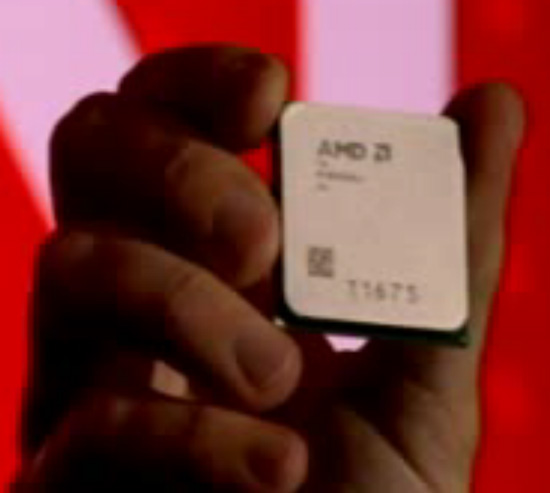
Trinity: AMD's 2012 APU
While AMD doesn’t use Computex to formally announce major new designs, that didn’t stop them from dropping a surprise on the crowd: Trinity. Trinity will be AMD’s first Bulldozer based APU, combining some variation on Bulldozer with some as-yet-unseen AMD GPU architecture. Trinity will launch in 2012 and will be the follow-up to Llano.
On an off-beat note, the name Trinity may have some yet to be seen significance. While AMD does like to name their products after Texas locations, trinity is also a well-known description of a grouping of 3. If it’s not named after Trinity, Texas or Trinity University, perhaps AMD is planning a trinity of their own?
New VISION Branding: A-Series
While as enthusiasts we tend to focus mostly on codenames, when it comes time for a product to reach retail it needs a real name. Although Llano isn’t launching until later this month, AMD used their Computex event to lay out their branding plans for Llano products. Joining the E, C, G, and Z series will be the A series. The A series will be AMD’s retail product branding for Llano products.
AMD APU Series APU Model Codename Market AMD C-Series Ontario Low-Power Mobile (9W) AMD E-Series Zacate Mid-Power Mobile (18W) AMD G-Series Ontario & Zacate Embedded AMD Z-Series Bobcat Tablets (6W) AMD A-Series Llano Mobile & Desktop The A series will be broken down into 3 tiers: A4, A6, and A8. At this point we don’t know what the differences will be between the tiers, but it’s safe to assume there will be some cache, GPU, and CPU differences between the tiers, based on what we’ve seen AMD do with their existing series.
AMD A-Series APU Tier Codename Configuration A4 Llano ? A6 Llano ? A8 Llano ? We must admit though that we find AMD’s choice on naming a bit odd here. While Advanced Micro Devices has more than a fair claim to an A-series, Apple and ARM have basically beaten them by 2 years. As a result there will be the AMD A4 standing alongside the Apple A4 (based on the ARM A8), and the AMD A8 standing alongside the ARM A8. Llano is not at risk of being confused with the aforementioned SoCs given the performance and power differences, but it’s not the most unique name.
On the other hand, the fact that AMD’s 3 tiers are 1 digit higher than Intel’s respective i3/i5/i7 tiers will not go unnoticed.
More...
-
05-31-11, 11:50 PM #514
Anandtech: More on Intel's Thin Mini-ITX Standard
I stopped by Intel's booth at Computex to grab a few shots of the small but potent Thin Mini-ITX ecosystem. If you read our coverage yesterday you'll remember that Thin Mini-ITX is just a low profile Mini-ITX standard designed for affordable (or potentially DIY) all-in-one PCs.
Intel had a number of Sandy Bridge motherboards on display that conform to the Thin Mini-ITX standard. Most of the boards use Intel's H61 chipset:
The cooling system is also standardized. Below is an example of the cooling solution Intel will be selling in Q4 of this year:
Intel also had a number of all-in-one cases available. While most weren't all that elegant looking, this model from Loop looked very Apple-like:
There were a number of DC power adapters on display, ranging from 150W to 180W. The power connector is also a standard.
Going forward as the majority of desktops move to even lower TDPs, these DIY all-in-one systems may end up becoming more popular. One major issue I see right away is the lack of support for discrete graphics. Go far enough into the future and perhaps that won't be so important, but today it's not fun driving a high resolution panel off of SNB integrated graphics. I do hope that as Intel pushes for this standard it doesn't forget that discrete GPUs are still quite necessary for many users in 2011. Maybe we'll eventually get that upgradable 27-inch iMac that I was asking for recently.
More...
-
06-01-11, 12:10 AM #515
Anandtech: Meet the New 5.25" Optical Drive Standard: Slimmer, Slot-loading
I was walking around the show floor today and caught a glimpse of Antec's Solo II chassis with a slightly different optical drive bay.
It turns out that there's a new optical drive standard being worked on in the industry. The standard is for slot loading drives with a half-height profile. The drives are still 5.25" wide, but they just aren't as tall as the older drives.
Cases that have a fold down optical faceplate won't work with these new drives, forcing case makers to adopt. This Solo II is an example of what a slot loading solution may look like.
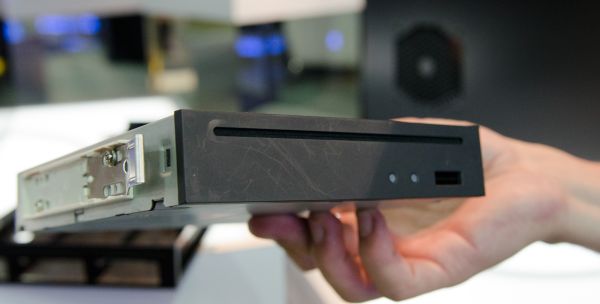
Expect to see these new slot load drives to hit the market by the end of this year, along with cases to match.
{gallery 1110}
More...
-
06-01-11, 12:30 AM #516
Anandtech: Computex 2011: AMD Announces Bobcat-based Z Series APUs for Tablet Market
While AMD does not have a true SoC to combat the likes of Intel, NVIDIA, and ARM, this doesn’t mean they’re completely ignoring the market for the type of devices SoCs normally go in. Announced today at Computex 2011 and shipping immediately will be AMD’z Z series APUs, AMD’s formal entry into the modern tablet market.
While at this time it’s neigh-on impossible to get into a phone without a SoC (just ask Intel), tablets can be more forgiving. With a larger device and a larger battery, such devices don’t necessarily have the same extreme integration requirements and battery life requirements as a phone, even if the processors used in such devices are often the same. As a result of AMD’s current resources and technologies, it’s the tablet market that they have decided to go after first.
The Z-series, codename “Desna”, currently has a single APU that is shipping immediately: the Z-01.
AMD APU Lineup APU Model Number of Bobcat Cores CPU Clock Speed GPU Number of GPU Cores GPU Clock Speed TDP AMD Z-01 2 1.0GHz Radeon HD 6250 80 276Mhz 5.9W AMD C-30 1 1.2GHz Radeon HD 6250 80 280MHz 9W AMD C-50 2 1.0GHz Radeon HD 6250 80 280MHz 9W AMD E-240 1 1.5GHz Radeon HD 6310 80 500MHz 18W AMD E-350 2 1.6GHz Radeon HD 6310 80 500MHz 18W The Z-01, as near as we can tell, is a power optimized version of AMD’s existing C-50 APU. It features the same dual-core CPU design, using a pair of Bobcat CPU cores running at 1GHz. The GPU meanwhile is a Radeon HD 6250, and while AMD hasn’t listed the clocks, we believe it’s clocked at the same 280MHz as in the C-50. We don’t have any information on whether AMD is using the same packaging for the Z-01 as they are the C series, but otherwise the available specifications are identical to the C-50 with one exception: TDP. While the C-50 is rated for 9W, the Z-01 is rated for 5.9W. Given the 33% power reduction, it’s a fair guess that AMD is binning Ontario chips to find ones that operate at the low voltages Z-01 would require.
Based on what we’ve seen with the C-50, the Z-01 should perform far above any other tablet processor. However the 5.9W TDP means that it’s not going to be in the same market as the likes of OMAP 4, Tegra 2, Apple’s A5, or even Intel’s Moorestown. All of these SoCs/platforms use well under 5.9W, and with the exception of Moorestown are all ARM based.
So what kind of tablets is AMD shooting for with the Z-01? The primary market is going to be full-fledged Windows 7 tablets, although Z-01 is capable of running the x86 branch of Android too. The first product will be the MSI Windpad 110W, which we actually saw earlier in the day before AMD’s announcement. The 110W is a 10” tablet running Windows 7 (Win7 Pro on the showfloor), which should retail for around $599.
Ultimately the biggest factor differentiating Z-01 tablets from ARM tablets is going to be Windows 7, given that a suitable version of Android is not yet available. Tablets like the 110W are going to be sold based on their ability to use applications like Microsoft Office, Windows Media Center, Windows games (that will run on a Radeon HD 6250 of course), and any other common Windows applications. So while devices like the iPad are based around media consumption, for Z-01 tablets AMD’s goals are more about a balance of consumption and creation, putting Z-01 tablets in a somewhat different market segment altogether.
We’ll have more on the Z-01 and the MSI Windpad 110W later this year once the tablet ships.
More...
-
06-01-11, 12:30 AM #517
Anandtech: Computex 2011: Antec's Solo II for $119
Antec also showed us its Solo II case at the show. A pretty standard looking chassis the Solo II is designed to be a good balance of functionality and performance. There's one fixed internal 2.5" drive mount, and the three tool-less 3.5" bays can accept either 2.5" or 3.5" drives.
You can also ditch the drive carriers and use the case's two suspension mounts instead.
Antec was pretty proud of the Solo II's large cutout for the CPU area, a design choice mirrored in the P280 we covered earlier.
Check out the gallery below for more pics.
{gallery 1112}
More...
-
06-01-11, 12:30 AM #518
Anandtech: Computex 2011: This is the Antec P280
Antec was eager to share with us its upcoming P280 chassis. The case we were shown is still a prototype but it's going to be Antec's flagship when it comes out later this year.
The P280 will be priced at around $169, similar in price to the P180 it will replace. Antec has relocated power/reset buttons to behind the front cover - apparently P180 owners with kids found that their children were always poking at the prominent power/reset button.
The front of the chassis has two USB 2.0 ports and two USB 3.0 ports, all of which are driven off of motherboard headers.
The P280 has three tool-less 5.25" drive bays, just depress the release lever and slide the drive out:
There are two 2.5" and six 3.5" bays inside the chassis. The 3.5" trays don't accept 2.5" drives by default unfortunately.
All fans in the case can be driven by a collection of 3-pin fan headers at the very back of the case. A single molex connector feeds power to the fan header PCB.
Antec improves cable management by offering even more room behind the motherboard tray to route thicker cables:
Check out more pictures of the upcoming P280 in the gallery below.
{gallery 1111}
More...
-
06-01-11, 12:40 AM #519
Anandtech: Computex 2011: Antec Implements Seagate GoFlex Standard
At this year's CES Seagate announced its intentions to open the GoFlex connector standard, enabling devices and other drivemakers to build products around its GoFlex removable drive standard. We've seen limited public uptake thus far, but at Computex Antec announced its intentions to include a GoFlex drive bay in some of its future cases:
The bay can accept either GoFlex compatible drives or, with the swap of an insert, standard 2.5" SATA drives. With a standard 2.5" drive in place, the bay can also accept another 2.5" drive internally.
The GoFlex or standard SATA drive plug into a PCB backplane which connects to your SATA controller via a standard SATA cable. No word whether or not Antec's solution will support 6Gbps SATA at this point or how well tested it is with SSDs.
Antec expects GoFlex to debut in cases by the end of the year, perhaps on the new Solo II.
{gallery 1113}
More...
-
06-01-11, 02:10 AM #520
Anandtech: Computex 2011: Some Time with Promise's Thunderbolt Devices
Yesterday Intel told us that Ivy Bridge would integrate both USB 3.0 and Thunderbolt into the 7-series chipset, that should help make both standards see more widespread adoption in 2012.
Two lines of systems currently support Thunderbolt: the new MacBook Pro and the new iMac, unfortunately there are no Thunderbolt peripherals available. Apparently both Apple and Intel want to approve devices before they go on sale, at least initially to ensure there are no embarrassing problems at launch. Although Promise showed off Thunderbolt enabled external storage devices at the Thunderbolt launch in February, we won't see availability until the end of June at the earliest.
Promise will release two external storage devices that use Thunderbolt as their sole interface: the Pegasus R4 and Pegasus R6. The difference between the two is strictly the number of drive bays; the R4 has 4 bays and the R6 has 6 bays. Both platforms support RAID 0/1/5/6 and 10.
The Pegasus enclosure has two Thunderbolt ports, one for input and one for output. Pegasus can pass through video, however the final connection to your display has to be via a DisplayPort cable since there are no Thunderbolt displays today other than what's integrated into the iMac/MBP. The Thunderbolt spec as implemented in the Macs supports up to 6 devices per root connection.
The Pegasus' bays support both 3.5" and 2.5" drives. Promise had a setup using Intel X25-Es although I'd expect SSD 510s to be used in any shipping products with SSDs. Pegasus does support 6Gbps drives, although the highest transfer rates I ever saw on the machine maxed out at 850MB/s despite the use of a 6-drive RAID-0. It looks like there may be some internal bottlenecks at work here.
Here's a shot of what a connected TB device looks like in System Profiler:
Activity Monitor accurately reports disk activity that happens over the Thunderbolt interface:
And of course performance results:
Promise also had its SANlink on display at the show:
The prototype takes a single Thunderbolt connection and allows you to bridge it to up to two 4Gbit Fibre Channel ports for connected a system to a beefier SAN.
{gallery 1114}
More...
Thread Information
Users Browsing this Thread
There are currently 15 users browsing this thread. (0 members and 15 guests)




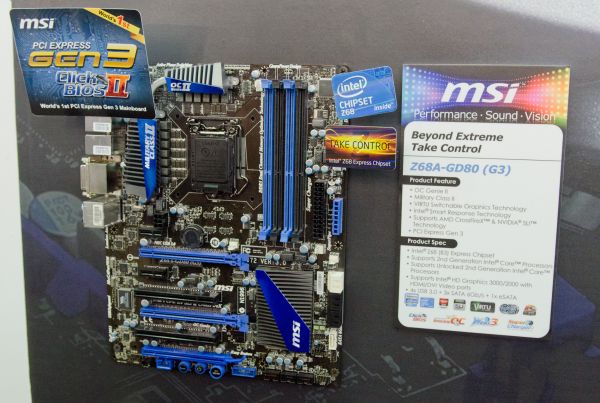
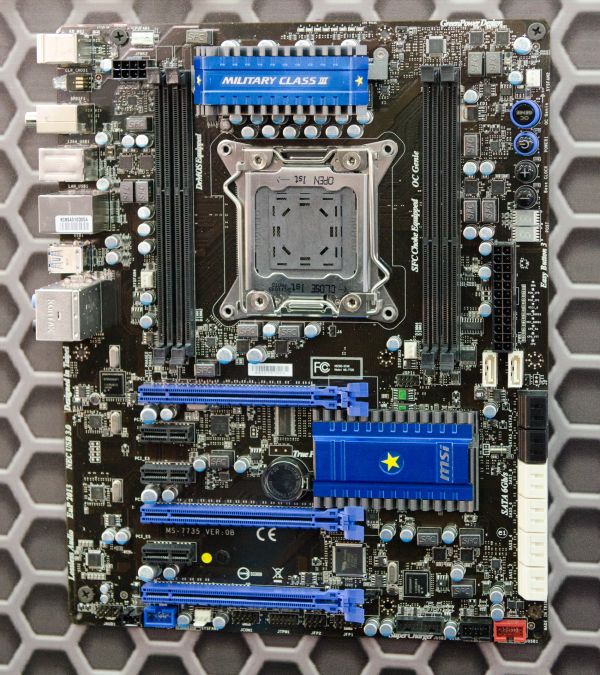

 Quote
Quote



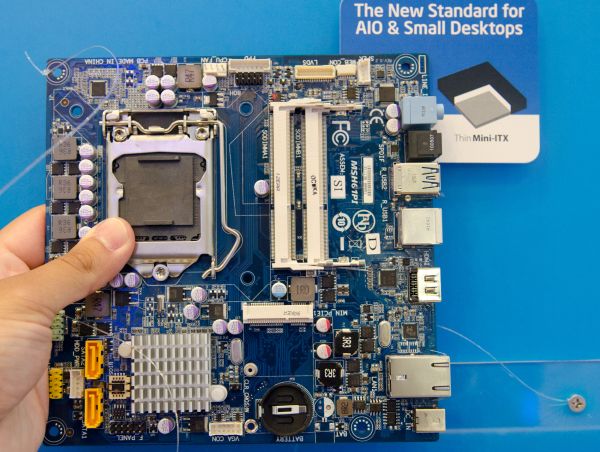
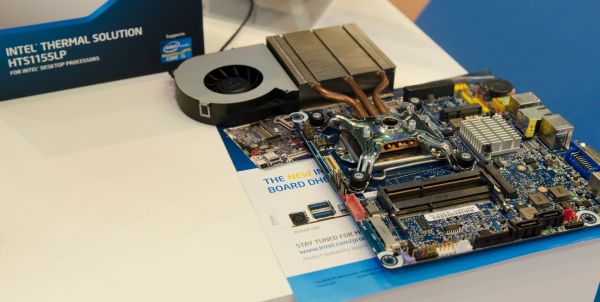
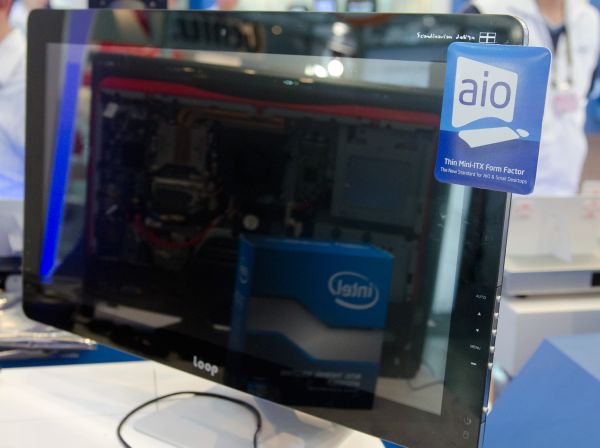

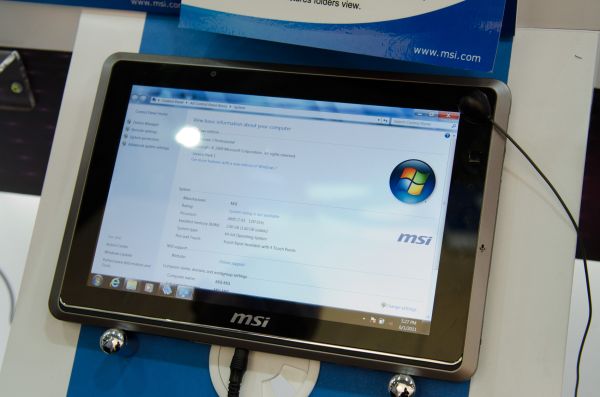






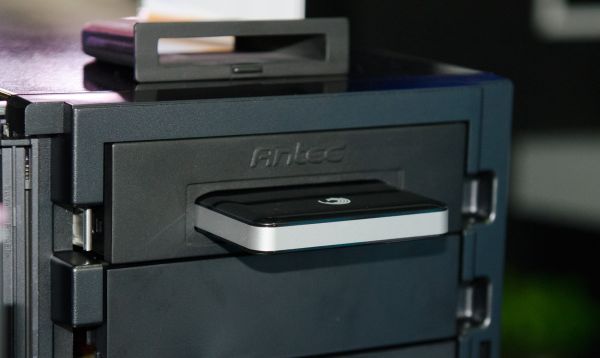
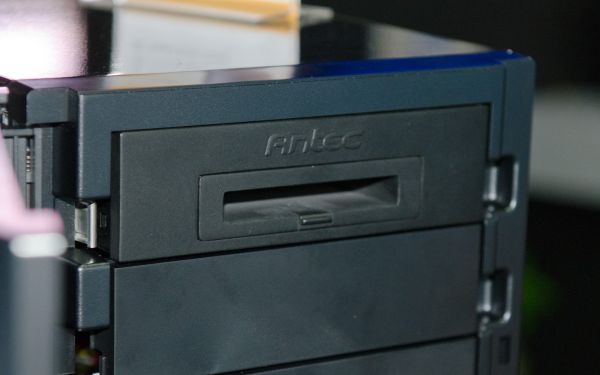
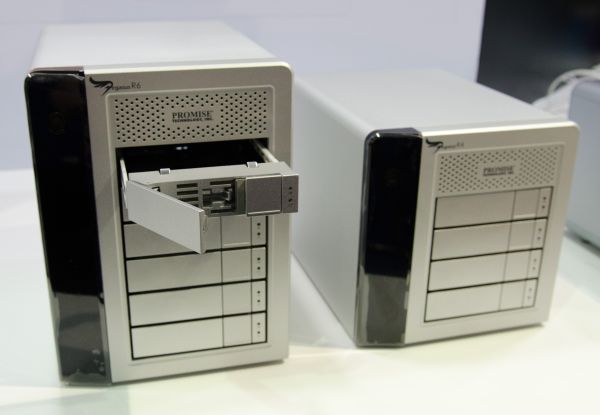
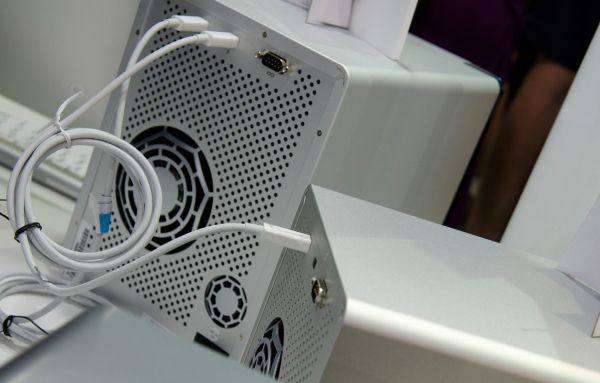
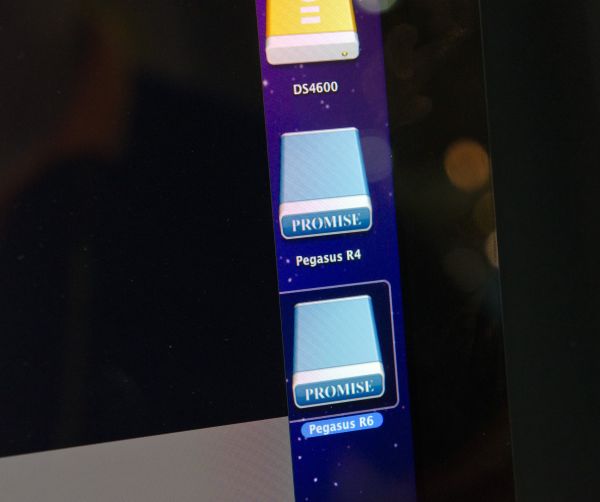
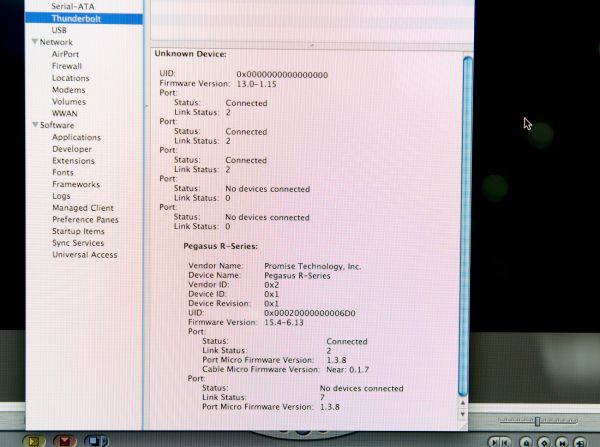
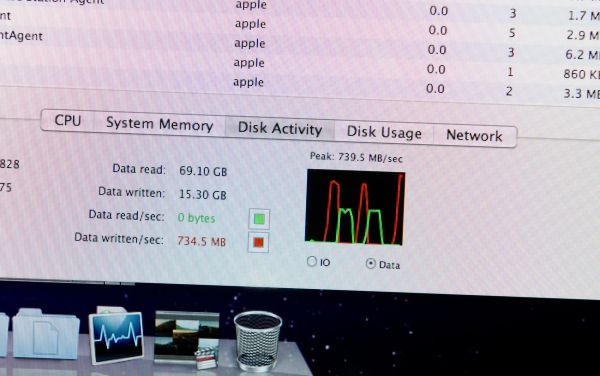

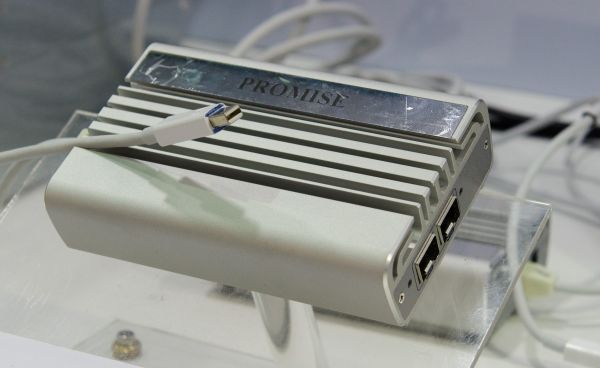
















Bookmarks